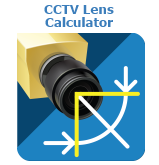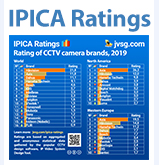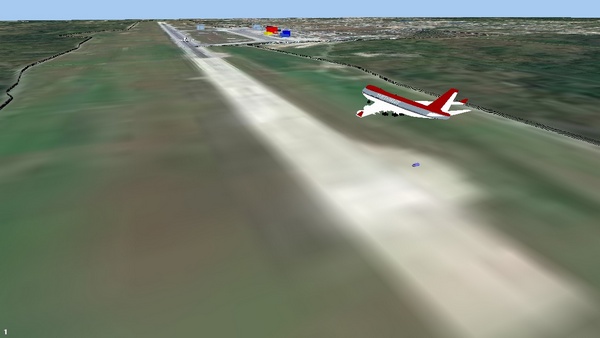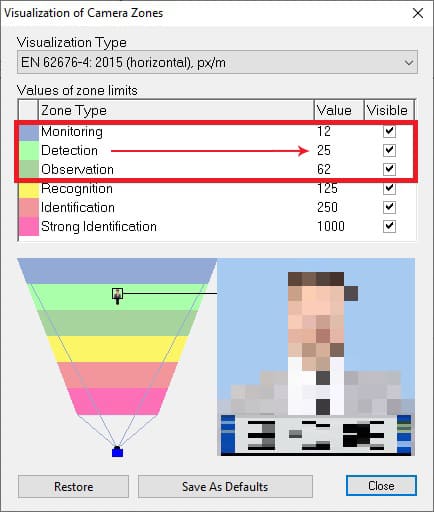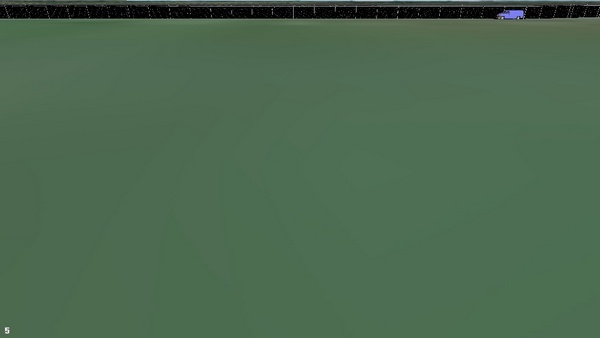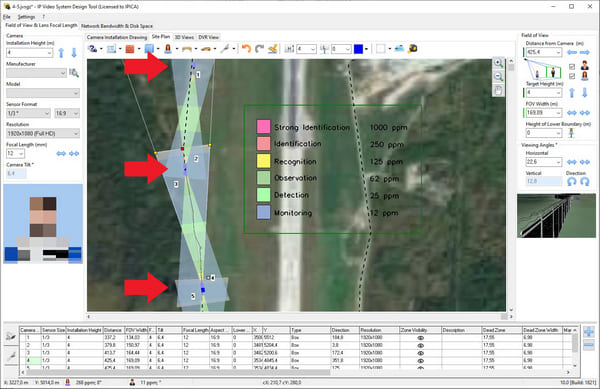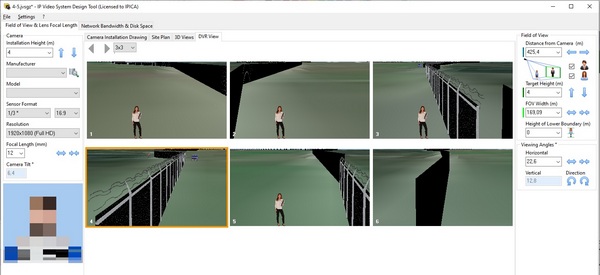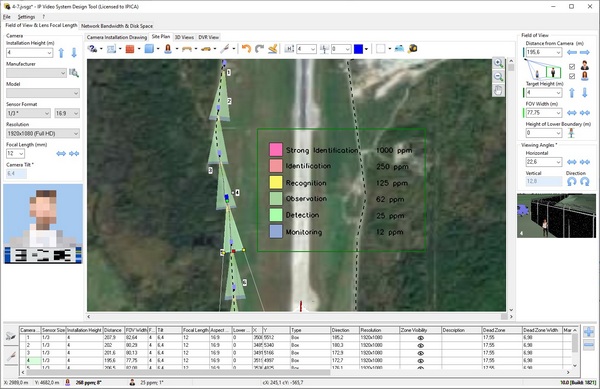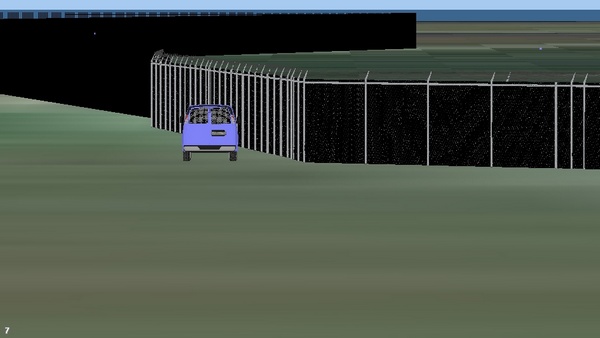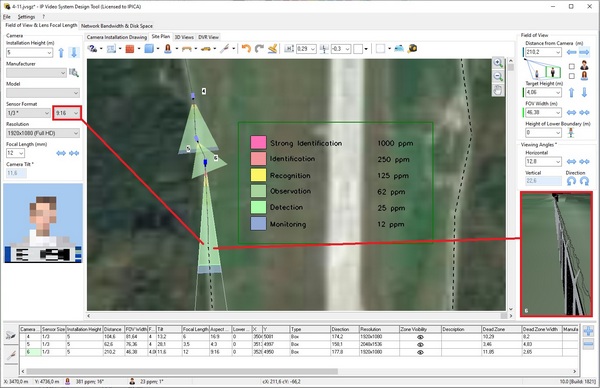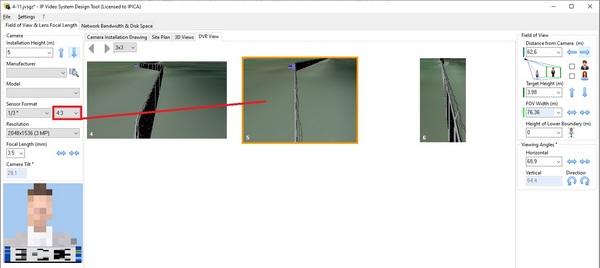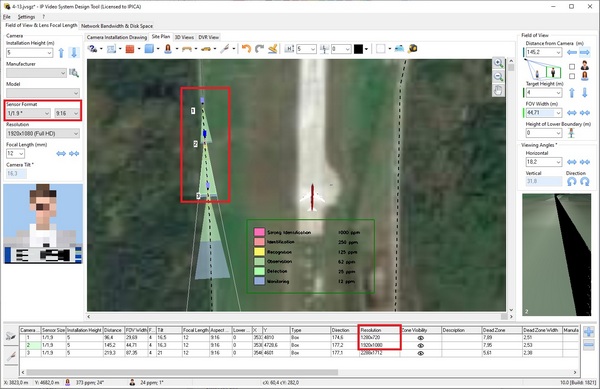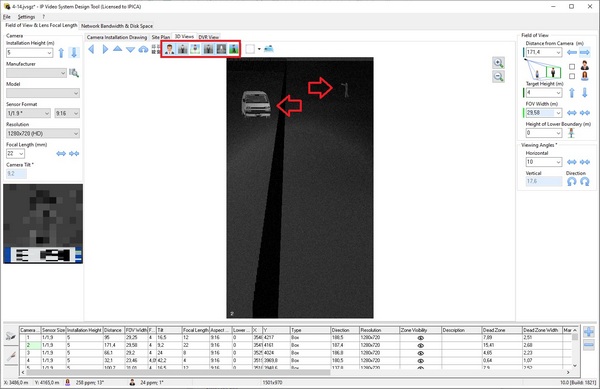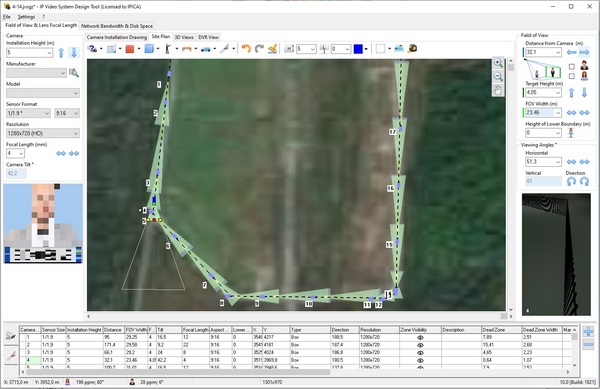Case #4 – Perimeter video surveillance system without dead zones: How to justify the selected installation distance
It is necessary to ensure continuous video surveillance of an industrial/transport/energy facility perimeter that is 1-2 kilometers up to 10-20 kilometers long without dead zones.
A topographical survey or satellite image (Google Map) with referenced engineering structures (perimeter fences, gates, portals, security checkpoints, etc.)
-
Please justify the selection of cameras to solve this task: Stationary cameras with fixed focal length, stationary cameras with varifocal lenses (the focal length is adjusted at the camera’s installation site or remotely if the camera is equipped with a motorized zoom), or high-speed rotating cameras.
-
Explain the selected method for camera placement: One opposite the other or one after the other? Along the perimeter line or facing outwards from the center?
-
Justify the selected spacing of the cameras.
-
Explain your choice of technical specifications of the cameras
Before selecting the method of placement and the technical specifications of the cameras, we should establish the criteria. When should we consider the task (video surveillance of the perimeter) successfully completed?
The main goal of the perimeter video surveillance system is to detect unauthorized entry onto the territory or attempts of such entry, through the coordinated actions of security units, post-incident analysis, and investigation.
The main detection criteria are specified in the European standard EN 62676-2015, and in similar British and Australian norms.
The intrusion detection probability requirement will factor into your selections for monitoring, detection, and surveillance information.
Placement of cameras
One of the main issues in solving this task is determining the method of camera placement that provides the maximum probability of intruder detection.
From the center, aimed at the perimeter
This option can only be used for low-cost projects with a very short perimeter, such as for protection of a private home. In other cases, this concept is absolutely ineffective because:
-
there is no way to detect approaching intruders before they enter the territory
-
it is impossible to isolate a “demilitarized zone” (the entry point that is considered a violation of the perimeter)
-
as a rule, significantly more cameras are required to cover the same section of the perimeter compared to the “along the perimeter” placement method
Among the advantages: uniform pixel density along the entire perimeter (uniform strength).
Along the perimeter, one facing the other
This is another option that has too many disadvantages:
-
An extremely uneven distribution of pixel density (spatial resolution) lead to the appearance of “weak” zones. The fundamental principle of uniform strength of the established safety boundaries is missing. The area under the cameras will be the least observable. Thus, this flaw is obvious for experienced intruders.
-
A perimeter of several kilometers (especially tens of kilometers) obviously would involve a large number of cameras. At the same time, the images on these cameras do not present much variety. It’s almost impossible to navigate such a multi-camera layout when the cameras are located facing one another.
The advantages of this option include the smaller number of supports required, lower price maintenance, plus an increase in the camera placement distance.
Along the perimeter, one after another
This is the classic, most preferable option since it’s convenient for perimeters of any length. Among the advantages:
-
A clear definition of the boundary between “our” and “their” territories in the demilitarized zone allows detecting the activity of an intruder before he penetrates the protected area. This task is easily solved by existing video analytic functions.
-
The relatively small unevenness in pixel density distribution allows one to construct a security protection of uniform strength.
-
Having all of the cameras facing the same direction greatly simplifies the situational analysis for observers at the monitoring center.
Rotating cameras play only small part in ensuring perimeter security. Upon detection of an intrusion, they help to detail the scene, verifying the alarms automatically generated by the video analytic modules of stationary cameras or individual perimeter security systems.
Despite the temptation to use rotating cameras in all locations, namely the reduction in the number of cameras installed due to the higher zoom power of such cameras and the 360 ° viewing capability, keep in mind they do not ensure a uniform perimeter strength. A rotating camera can only observe part of the assigned territory at any given moment and the zone observed is random and situational, which makes it completely unsuitable for either intrusion detection or post-incident analysis.
Camera installation height
It is optimal to install cameras above any obstacles so that the obstacles do not obscure the observation zone of both the inner territories and the outer approaches.
Choosing camera specifications
The probability of intrusion detection is influenced by a number of factors: image detail (pixel density), camera sensitivity (the ability to obtain a high-contrast image in low light conditions) and the optical density of the medium (presence of precipitation, fog, smoke, or anything limiting visibility). You should choose the best option that is a compromise between the demands of saving resources (increasing the camera placement distance) and the reliability of the system in different conditions.
The main options include 4:3, 16:9 and 9:16 (the so-called corridor mode). The most economical in terms of increasing camera spacing is the 9:16 frame ratio.
The 4:3 frame ratio is the most balanced in terms of control of the adjacent territory at the cost of camera spacing distance, which is slightly smaller than in the previous case. The less desirable option is the 16:9 frame ratio, as it covers too much of the adjacent territory, generally requiring an excessive decrease in camera spacing.
Sensor resolution and size
The higher the resolution of the sensor, the more detailed the resulting image, which means a larger distance between cameras can be chosen to maximize intrusion detection in the protected area. But nothing is that simple. At the same sensor size, higher resolution means lower sensitivity (simple mathematics and physics – the sensor is divided into a larger number of pixels, each pixel gets less space on the matrix, less light is absorbed by each pixel to form a contrast image).
Therefore, you should always look for a balance between camera spacing, the opportunity to install security lighting in the demilitarized zone, and the probability of intruder detection. As a rule, large image sensors with a relatively low resolution of HD/720P or Full HD/1080P are mostly used for the protection of extended perimeters.
At the same sensor size, the longer the zoom of the lens, the farther away we can detect an intruder. But once again, nothing is that simple. Long-focus lenses have a limited depth of field, which is an important consideration when working in periods of darkness. The built-in IR illumination of cameras is also limited in power and illumination angles, restricting the detection range at night. In addition to this, don’t forget about the optical density of the medium mentioned above — rain, fog, snow, or smoke reduce the maximum target detection distance. Therefore, you need to compromise between camera spacing and the target detection probability.
The second point that must be considered is the non-linearity of the perimeter, which is where the viewing angle needs to be increased and the camera spacing decreased.
Thus, camera spacing will not be constant, increasing in straight sections and decreasing in places where the engineering obstacles make a turn. On average, a distance of 50-70 meters between cameras can be considered adequate.
Designing perimeter surveillance systems is a very difficult task and requiries consideration of many factors. The best solution is to place cameras along the fence to control the adjacent territory and the inner demilitarized zone of the facility. Each previous camera controls the “dead zone” of the next one, thereby ensuring the uniformity of strength of the entire security system. The camera spacing distance is chosen for the purpose of detecting intrusion into a specific section of the perimeter. On straight sections, you can choose telephoto (12-16 mm) lenses, thereby increasing the positive intruder detection zone. When monitoring a zone where an engineering barrier makes a turn, it’s necessary to reduce the focal length (up to 3.6-10 mm) in order to increase the viewing angle, requiring camera installation at reduced intervals. Camera resolution should be chosen based on a compromise between the intruder detection distance and camera sensitivity, generally not more than 1.3-2 MP. As a result, the average spacing of cameras is 60 meters. Rotating cameras should be used only in addition to stationary ones, increasing the effectiveness of security, especially when coordinating response services. It is permissible to build a perimeter security surveillance system purely on PTZ cameras when there’s a well-established perimeter security alarm system integrated with a video surveillance system.
Video Surveillance in Retail | Identification Task
Download IP Video System Design Tool [360 MB for Windows 10,8,7] | Free CCTV Storage Calculator


